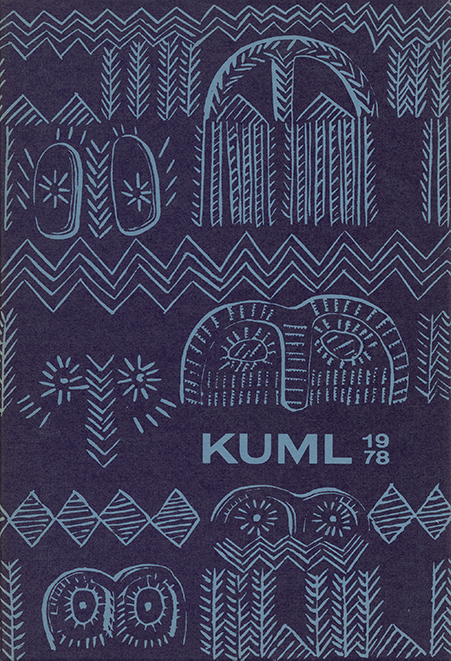The Bagergade find in Svendborg. Wasters from a medieval pottery kiln
DOI:
https://doi.org/10.7146/kuml.v27i27.106896Keywords:
bagergade, svendborg, waste, medieval, pottery kilnAbstract
The Bagergade find in Svendborg. Wasters from a medieval pottery kiln
The pottery find from Bagergade in Svendborg, Funen, consists of 35 pieces (fig. 1). It was found in 1925 and is one of the five Danish finds of wasters from medieval pottery kilns known to-day (Farum Lillevang and Faurholm in North Zealand, Åle and Illerup in East Jutland). Until now only the Faurholm find has been finally published. (1-6). The trade in pottery in Denmark is briefly discussed: local trade, imports and a possible export to areas like Norway and the southern shore of the Baltic. (7-12).
The Bagergade find is identified as wasters from a kiln for the following reasons: In many respects the material is remarkably uniform; there are, for example, only two shapes of thumb marks at the bottom of the jugs. Further, about half of the sherds have an applied decoration, and such pottery is meant to be glazed. But glaze is present on only six sherds and only in small areas. Five of these sherds are decorated with applied scales (fig. 7, 9, 11). On two of the sherds mentioned part of the glaze material has formed drops of lead (13) (fig. 2, 9a). Two other sherds have cracked (fig. 1t and 3b), but real deformities seem to be absent. It is possible that a low firing temperature is the reason for the mishap. The locality of the actual workshop is unknown -an excavation in 1973 showed that the sherds found in 1925 belonged to a later infilling of the area. (14).
All identifiable sherds are of jugs one of which has been tentatively reconstructed (fig. 12). The jugs were thrown on a fast wheel. Their thickness is comparatively small (0.4-0.6 cm). The glaze has a clear light green colour on the side of the jugs, but where a scale is glazed the colour is brown (15-17). Elements of shape and decoration allow seven different jug models to be identified:
- Jug with cut-off base: No decoration on the lower part of the belly (as fig. 3a, 4a, 5a).
- Jug with small, closely applied thumb marks at the base. No decoration on the belly (as fig. 3c, 5c).
- Jug with small, closely applied thumb marks at the base. Horizontal grooves clearly visible on the outside, probably starting 8-9 cm over the base and probably covering the rest of the jug up to the neck at least (cf. fig. 1i, 3b, 4b, 5b).
- Jug with profiled rim, rod handle and on the upper part of the belly two fillets framing groups of 3 scales. Green glaze on the side of jugs and brown on the scales (as fig. 9-10).
- Jug with large thumb marks at the base, probably a profiled rim and a rod handle. Applied decoration of scales arranged in two alternating vertical bands. Glaze as described under d. Height probably c. 30 cm (as figs. 11 and 12).
- Jug with large thumb marks at the bottom and a decoration of applied raspberry stamps arranged in horizontal and vertical bands. The jugs must have been glazed (as fig. 1aa).
- Jug as described under f but with smaller raspberry stamps (as fig. 14). In addition there is possibly a jug with decoration of scales in larger groups than described under d and e (cf. fig. 1n).
In general, it may be said that the jugs were probably quite broad and tall (jug model a is a possible exception). The jug of model e can probably be regarded as a rough standard for the dimensions of the other models with applied decoration. As almost all Danish medieval jugs had a spout, and a spout sherd (fig. 6) belongs to this find, the jugs of Bagergade probably also had one. Likewise it is probable that all the jugs had profiled rims, as this was the rule for jugs of the period. It can further be suggested that the workshop mainly or only used rod handles. This was the case for the Farum Lillevang workshop, (18) while the Faurholm workshop and the two in Jutland had a penchant for strap handles (19). Bases like those on models a-c probably belong to jugs without much decoration, while bases like those on models e-g probably belong to jugs with applied decoration. Nothing indicates that jugs of models a-c were meant to be glazed -unglazed jugs with a simple decoration or none are well known in Funen as well as in other parts of Denmark (20) -but the possibility of glaze cannot be ruled out.
The workshop of whose production a little has been found in Bagergade thus had quite a repertoire in jugs. It was larger than the Faurholm pottery's (21) and probably also the Jutland potteries (22). But with only 35 sherds the repertoire of Bagergade cannot compare with that of 'Farum Lillevang' (23). Other products of the workshop of the Bagergade find have not yet been identified (24-26). The dating relies on the conventional dating of decorated medieval jugs, say 1225-1375 (27). According to a modern functionalistic and aesthetic view the jugs -or at least the decorated ones- were of very high quality and belong to the best Danish medieval pottery. If the Middle Ages shared this view, and if pottery was exported from Denmark in that period, the workshop of the Bagergade find is a likely supplier.
Else Roesdahl
Downloads
Published
How to Cite
Issue
Section
License
Fra og med årgang 2022 er artikler udgivet i Kuml med en licens fra Creative Commons (CC BY-NC-SA 4.0).
Alle tidligere årgange af tidsskriftet er ikke udgivet med en licens fra Creative Commons.


